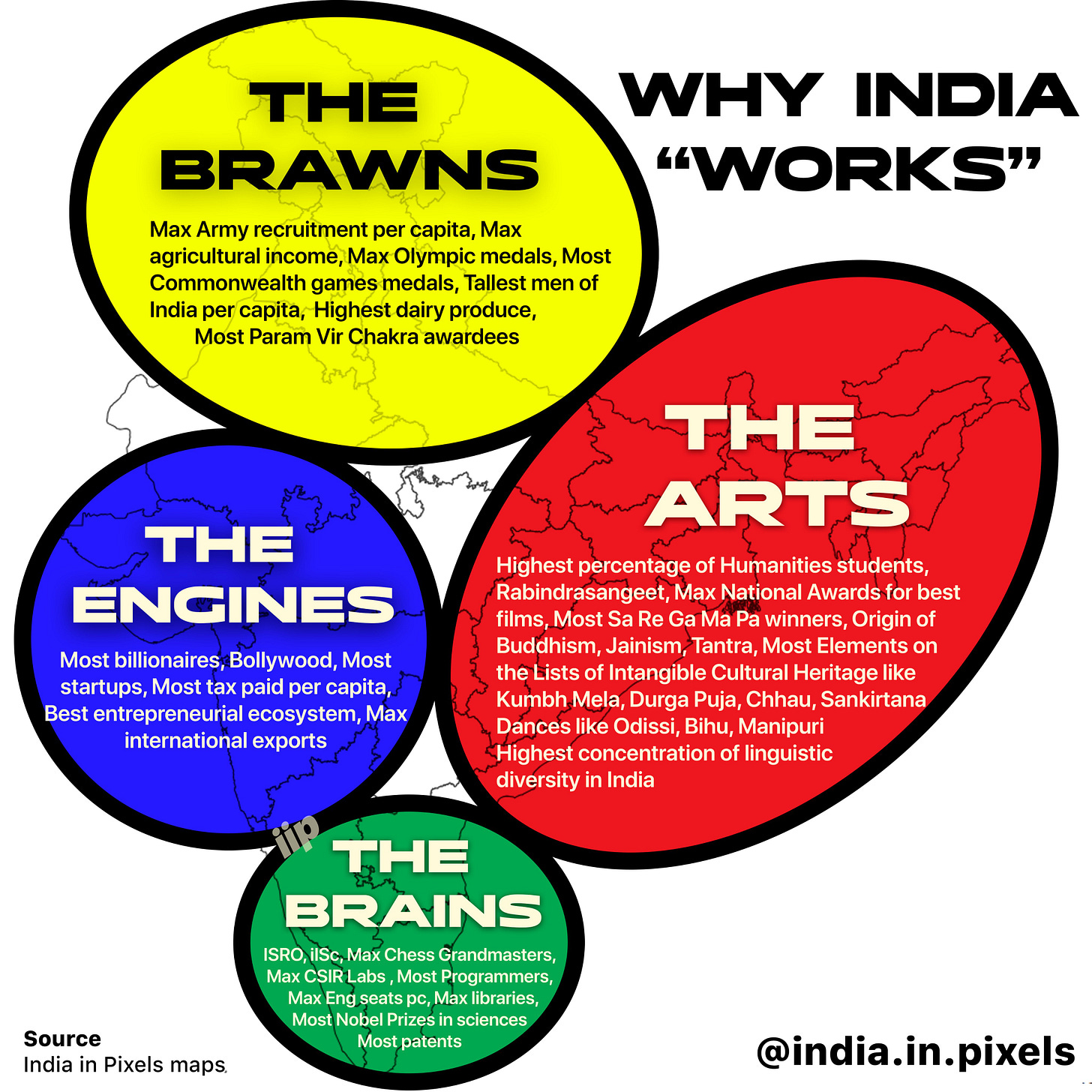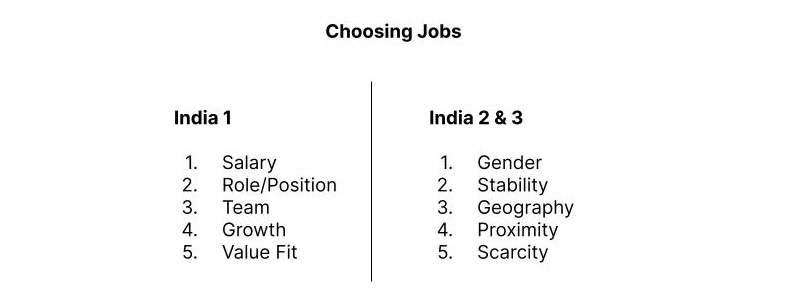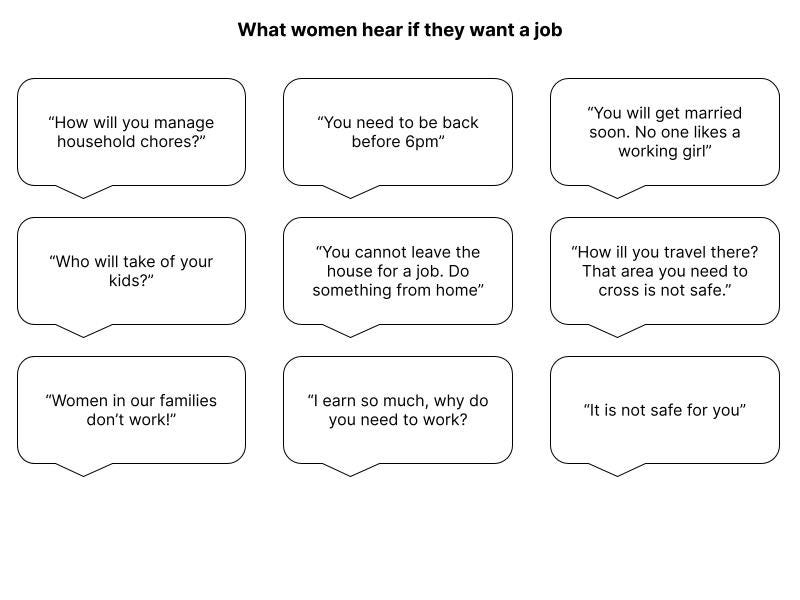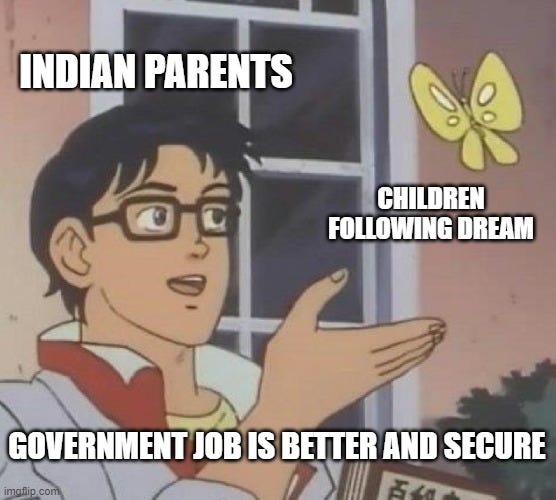How do Indian youth choose their careers?
Career decision-making and its impact on learning
Hey there 👋
Dharmesh Ba here. If you enjoy reading my newsletter and want to collaborate with me, check out 1990 Research Labs. We are a boutique user research consultancy located in Bangalore. We have worked with several top startups, including Duolingo, CRED, Plum Insurance, Udaan, Allen Digital, and Jar.
Today’s newsletter is written by Srishti Sehgal 💥
In India, a simple but powerful idea has held the test of time: Learn now so that you can earn later.
Coaching institute giants like ALLEN, FIITJEE, Unacademy, and PhysicsWallah have created large businesses around this idea. The test preparation market is set to skyrocket by a whopping $9.07 billion from 2021 to 2026, as per this report by Technavio. This staggering growth underscores the belief that education leads to economic opportunities.
But the number of white-collar jobs created yearly is only 4.3% [Blume Ventures report ] of the number of students graduating. This gap has led to a new college-to-job transition market valued at $458 billion. Organisations like Emeritus and UpGrad focus entirely on career support to get a job.
The ‘so that’ mindset in learning
The fact that learning is outcome-based is so embedded in our culture that it propagates a set of dangerous assumptions:
Learning = doing well in exams
I only need to learn until the "X" point
If I reach the "X" point - I've achieved my dream
“Study till 10th grade because that will help your choice of subjects in 11th.”
“Get good marks in 12th grade - so you get into a good college.”
“Do well in college - to get a good job.”
What you learn affects your career and what you pick as your career in turn affects your learning.
But how do people choose jobs?
India 1 primarily looks for five signals in jobs: salary, role/position, team, growth, and value fit. But for India 2 & 3 or Bharat, choosing jobs is more complex than you’d imagine. While they also might have some of these considerations, the primary decision-making factors are not the same, influenced mainly by their context.
In this article, we will discuss the five factors that influence career decision-making for youth in India (2 and 3). We will also explore how these factors impact the way they learn.
#1 Gender: “Because you’re a girl.”
In many Indian households, career choices for women are often restricted by cultural norms and family expectations. Parents may not allow their daughters to work outside the home, or if they do, there are conditions such as being back home early, working close to home, or managing household chores alongside work.
As a result, the career choices for women end up being restrictive - women often end up in careers like beauticians or running small like tailoring from home. Marriage can further limit career options, as unsupportive husbands and in-laws may discourage women from continuing their careers.
Conversely, men are typically expected to be the primary breadwinners and prioritise work.
Gender plays a vital role in the access, choice of learning and careers in India.
How does it influence learning?
Access to learning: Family dynamics and caregiving responsibilities often disproportionately burden women, affecting their ability to prioritise education and career development and further perpetuating gender disparities in the workforce.
Choice of higher education: Women may focus more on "craft" and "art" based learning to pursue hobbies or develop business skills. Safety concerns often lead parents to prefer all-girls colleges or courses for their daughters. In contrast, men prioritise learning opportunities that will lead to higher-paying jobs.
#2 Stability: “Just get a government job, and your life will be set!”
91% of the total workforce in India consists of workers in the informal sector, according to the Periodic Labour Force Survey 2020-21 by the Indian Government. This means most of our population is working in professions like daily-wage, agriculture or contractual jobs that don’t have a stable source of income. As a result, government jobs are highly aspirational for the stability and security they offer.
While in an urban household - a doctor, engineer or (heck!) even a YouTube Creator is most aspirational nowadays, folks in most areas still aspire to be IPS and IAS officers.
Careers that promise a stable income or a secure future are prioritised.
How does it influence learning?
Transactional Learning: Pursuing stability often leads to a transactional approach to learning, where individuals focus solely on acquiring knowledge necessary to pass exams or meet job requirements rather than engaging in deep, meaningful learning experiences.
Narrow Skillset: The narrow focus on stability-oriented careers may result in individuals developing a limited skill set, as they prioritise acquiring specific qualifications or competencies relevant to their chosen career path. Often these skills end up being quite dated and are not able to keep up with the changing times.
#3 Geography: “I want to work near my house.”
Geography plays a significant role in career choices and learning opportunities. In a state like Gujarat, more people want to pursue entrepreneurship, whereas in Bihar, youth aspires for government jobs.
Geography is often a constraint for job selection as well. The COVID-19 pandemic caused trauma and fear among migrant workers and their families. Youth also prefers to work in their native language further causing them to be restricted by jobs in their states.

How does it influence learning?
Limited access to learning opportunities: Geographical constraints limit individuals' access to educational resources, such as quality schools, libraries, and vocational training centres, thereby restricting their learning opportunities and career prospects.
Restrictive curriculum: Educational institutions in remote areas offer limited curriculum choices, focusing primarily on traditional or vocational subjects aligned with local industries, which may not align with broader career aspirations or market demands.
#4 Proximity: “Like Sanjay Bhaiya”
Individuals often base their career aspirations on the role models and opportunities available in their immediate surroundings. Friends, family & their learning & career choices are what influence people’s decision making - this further propagates the geographical pockets of careers & learning preferences.
Despite the influence of media, personal interactions and local role models still carry significant weight in shaping career aspirations.
How does it influence learning?
Limited exposure: Reliance on local role models and experiences can limit individuals' exposure to diverse career paths and learning opportunities, leading to narrow career aspirations and educational preferences.
Lack of mentorship: Limited access to mentors or professionals outside of one's immediate vicinity may hinder individuals' ability to receive guidance and support in exploring alternative career options or expanding their skill sets.
#5: Scarcity “I want money fast”
Due to lack of disposable income at home, highly constrained upbringing, and more often a necessity to provide back to home - youth entering the workforce face a lot of pressure to immediately start earning money. Scarcity is the norm for people.
Many individuals in India prioritise short-term career gains and instant gratification over long-term career development. As a result, people choose the quickest path to make money over everything else. Oftentimes this comes at the cost of them putting in some effort that will help them lead to a better job and better pay. They aspire to earn substantial incomes quickly, but don’t necessarily have the vision to look at careers as a long term goal that they need to keep working towards.
How does it influence learning?
Lack of motivation: As individuals focus on acquiring knowledge or skills necessary to achieve immediate career objectives rather than delving deeper into subjects or pursuing genuine intellectual curiosity.
Focus on learning more commoditised or low-paying skills: In comparison to high leverage ones (E.g. driving, data entry etc) in order to get a job as quickly as they can. It might be efficient in the short term as the entry barrier is quite low, but doesn’t really lead to long term gains.
Summary: Building a hopeful future
In navigating the complex landscape of career decision-making and its impact on learning, it becomes evident that India's youth face multifaceted challenges and opportunities. The intertwined relationship between learning and earning underscores the pivotal role education plays in shaping economic opportunities and social mobility.
And while for India 2 & 3, there are multiple factors that determine their choice of learning & careers. There are exciting opportunities that can shape this landscape:
Gender:
How might we design our learning to challenge gender stereotypes not only for the end learner, but also focus on parental/family education as well?
How might we design our jobs considering the constraints that most women face from their families?
Stability:
How might we educate people about managing finances & becoming financially stable even if they work in unorganised sectors?
Geography:
How might we foster entrepreneurship to create more jobs in villages and small towns?
Proximity:
How might we build more diversity in role models for youth while keeping it local & contextual to build relatability?
Scarcity:
How might we help youth build a more realistic picture of their careers - job roles & salaries?
Which of these opportunities are you most excited by?











Great insights! Especially the point about proximity and why that came about
Proximity bias is so true. I have seen this so close. Giving kids exposure to careers across domains must be done early on by parents and schools (or anyone in capacity to have positive influence on kids).
Great read ♥️